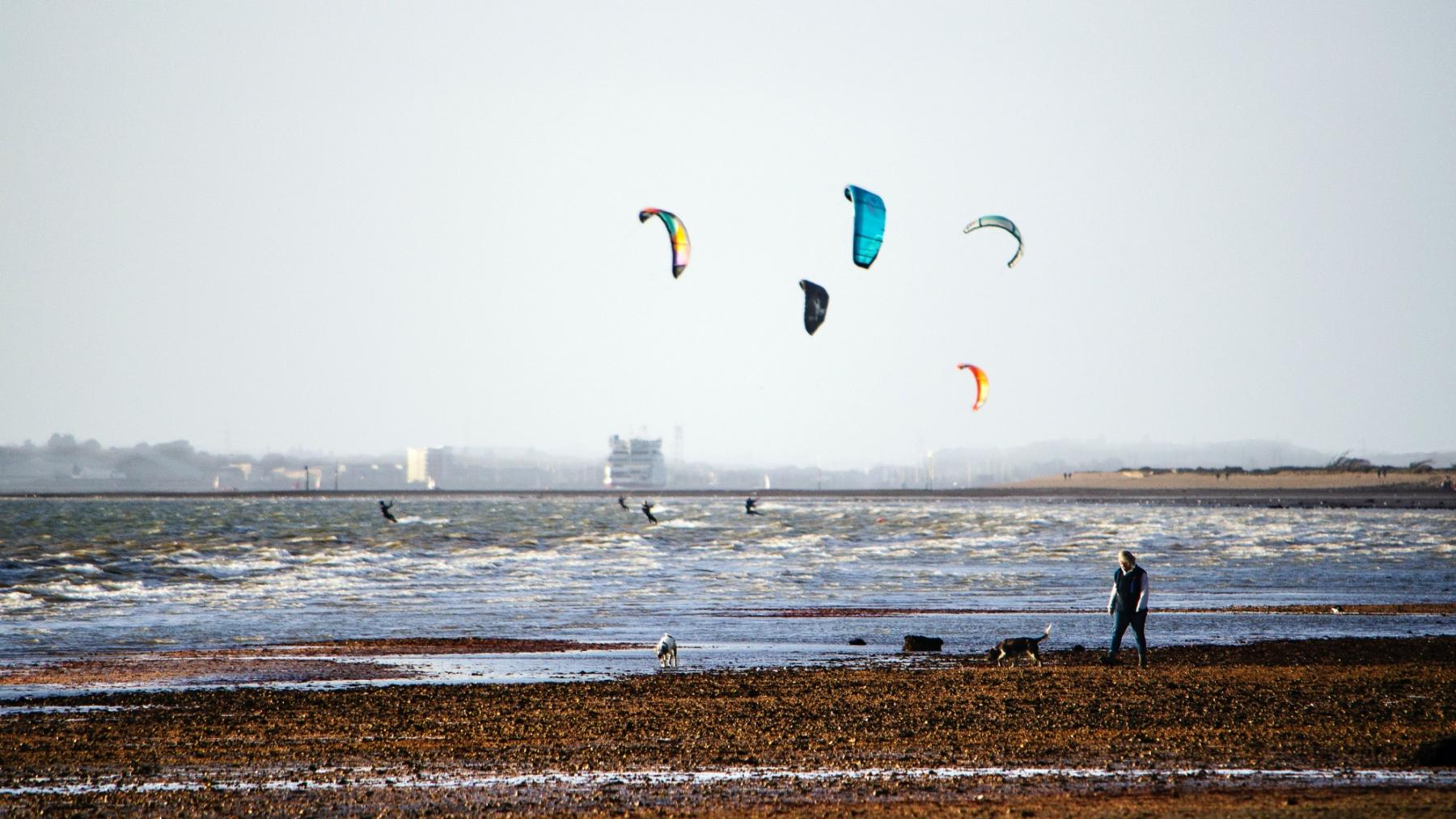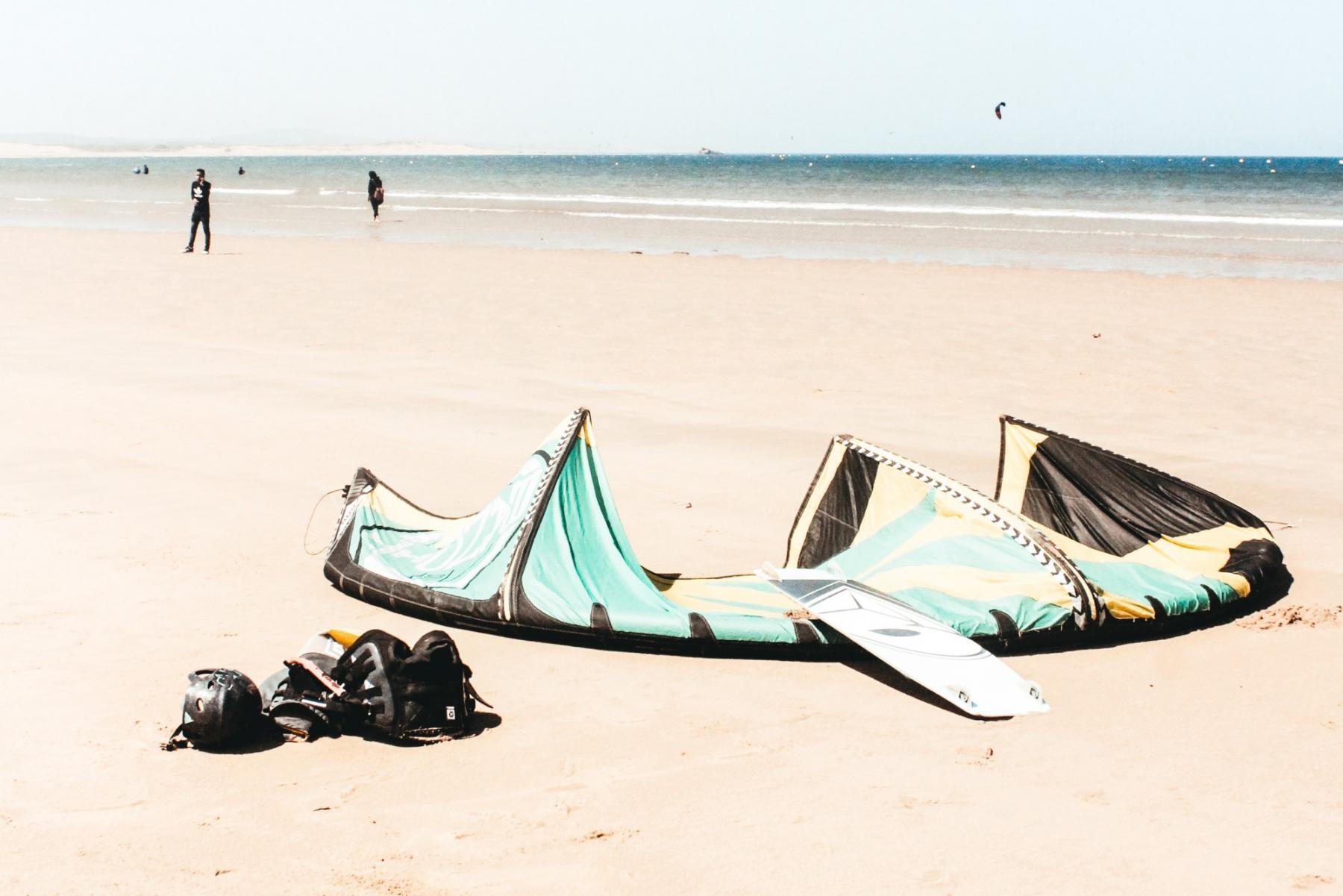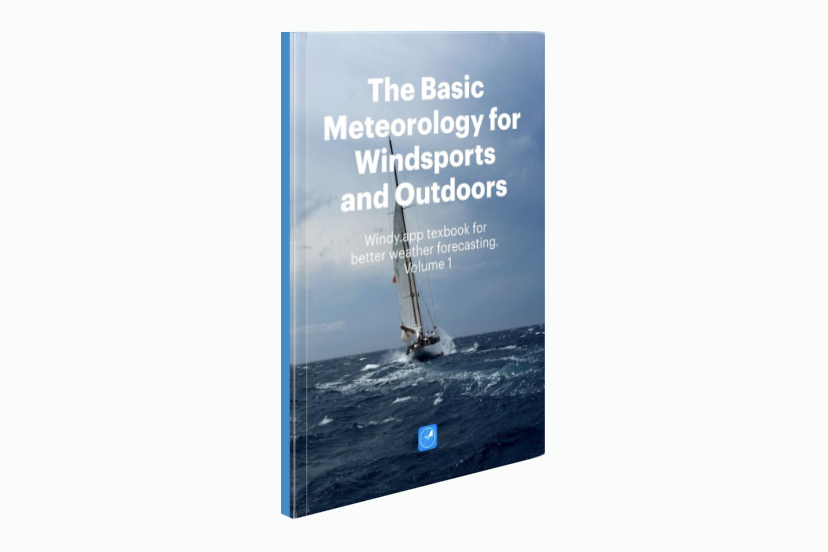
Kitesurfing
Kiteboarding or kitesurfing is a water and wind summer sport and outdoor activity. The name comes from the words "kite" and "surfing" or "boarding", which, in turn, means "moving on the board".
In kitesurfing, you move on the board under the action of the traction force of the kite. Therefore, the wind is a must for this sport. With enough wind, you can steer the kite to get more power and move upwind or downwind. So you take a board, inflate a special sail called "kite" (something like a parachute), which you hold with a rope, stand on the water, and... the wind carries you over the waves.
You can practise kitesurfing on any large open water where there is also wind. Such places are called "spots". Usually it is a beach on the shore of the sea or a large lake.
Kitesurfing is usually done in the summer when the water is warm and there is a wind. To do it all year round, you need to travel to those spots with appropriate weather conditions. The main kitesurfing spot in the world, a mecca of this sport is Tarifa, Spain. There is always a good wind also in Mui Ne (Vietnam), Maui Island (Hawaii, USA), and many others places.
The faster the wind, the faster you go. You can even jump or fly over water. This is one of the main pleasures and reasons of doing kiteboarding. It also differs from other sports by a close and friendly community where everyone is willing to support each other. However, learning the sport is not as easy as it seems at first glance, especially by yourself. In addition to wind, water and board for this sport, you need good physical training and courage. The sport is considered extreme.
If you haven't tried this outdoor activity yet or want to improve your skills and get to the next level, this guide to kitesurfing from the Windy.app team is just right for you.
Brief history
Kitesurfing was created in the 1990s by Chris Moore, an American hacker, from town of Lenexa, Kansas, outside Kansas City, Missouri. So it is a relatively new but already very popular worldwide, and its popularity is only growing. Actually, it is one of the fastest-growing sports in history, a sport that even New Yorker magazine writes about.
In 2009, the World Sailing, an International Sailing Federation, officially recognized kiteboarding as a sailing sport.
Types of kitesurfing
We have already mentioned, that, in fact, kiteboarding has two names or two main types of the sport, which you can come across by reading articles like this one. The second name is kitesurfing. There is no consensus in professional and amateur circles on what the sport should be called: some say it is the same thing. Others say that the difference is the type of board. In the first case, it is similar to a wakeboard (when you ride it behind a boat), in the second — a surfboard. Some say the former is more popular than the latter — and vice versa. Later in the guide, we'll use both.
(Also kitesurfing is often confused with windsurfing, but we will talk about that in the next article).
Kiteboarding also has a winter version, and there are two of them: snowkiting (with snowboard) and kitemountainboarding (for truly brave athletes). For snowkiting, a wind speed of several m/s is enough, for sea kiteboarding you need a minimum of 6 m/s.
Styles of riding in kiteboarding
There are three main types of riding in kiteboard (in the summer on the water): freestyle, freeride, high flying. Аs for the last one, a professional kiter can not only jump 10–15 meters but also fly a distance of 100 meters or even more — this is about 10 seconds of free flight.

Photo: uniqsurface / unsplash
Kitesurfing equipment and gear
To do kitesurfing you need a certain amount of equipment. Let's talk a little bit more about kites and boards, as well as other things you can't do it without:
Kitesurfing kites
There are two main types of kites: tube kites and parafoils. They are fundamentally different in design and the possibilities of their use.
- Foil kites or parafoils. A foil kite looks like a parachute or wing. Its canopy doesn’t have a rigid frame, so the shape is maintained by the oncoming air flow, which enters through special air intakes.
- Tube kites or leading edge inflatable kites. The frame of such a kite is created by inflatable balloons, which are located along the leading edge of the wing and across it. Inflatable kites don’t sink, are easily restarted from water, have a wide wind range, and are well controlled in gusts.
Then, there are several basic types of inflatable kites: C-kites, Bow kites, Hybrid kites, Delta kites. But, our guide is called "brief," so we must move on. Read about them these types of kites in a separate detailed article.
Kiteboarding boards
Kiteboarding boards are different, too:
- Twin-Tip board. The most common type of board, well suited for freestyle, wakeboarding, freeride, and high flying. The straps are used as fasteners.
- Wake-style board. Stiffer, larger rocker, boot-style foot bindings.
- Wave board. A unidirectional board is similar to a surfboard but optimized for kitesurfing with loop bindings.
- Race board. Unidirectional fast riding board with longer fins.
For kitesurfing, there are different board shapes: rocker (bottom curvature), width, outline. The form should be chosen according to the style of riding. The larger the board, the lower the wind range to be able to use the kite, and vice versa.
For snowkiting, it is a snowboard, for kitemountainboarding it’s a variety of boards with durable inflatable wheels.
Control Bar and Lines
The bar is a kind of "handlebar" to control the kite. It is attached to it by special long cables (lines) of a certain design — usually three lines.
Harnesses
As you can guess, it is very difficult to hold a kite, that is driven forward by the wind, by the strength of the arms alone. Harnesses are used for this purpose. With a harness, you connect yourself to the control bar (using the chicken loop). It then transfers the pull of the kite to your waist.
Other kiteboarding equipment
For kitesurfing, you will also need other additional equipment depending on the level of your riding skills, the situation at sea, the weather and the season, and other things: short kite leash, helmet, wetsuit, buoyancy aid, line cutter, and some other.
You can also use water sport sunglasses, sun protectors, rash guards, GoJoes (safe board recovery aids), walkie-talkie systems, waterproof mp3 players, etc.

Photo: louis-hansel-shotsoflouis / unsplash
Kiteboarding dangers and safety rules
An important advice: when preparing for kitesurfing, remember the main rule of this sport — never ride alone. It is a general rule, because a kite, especially an inflatable kite, cannot be launched and landed alone — there is a risk that it will tear.
It's also a general safety rule for such an extreme sports — to let someone on shore know that you're on the water.
Popular spots for kiteboarding
Popular places for this water sport are located on warm beaches. The most famous of them:
Tarifa, Spain
It’s the capital of the winds and the most popular kitesurfing spot in Europe. Because of cyclones from the Atlantic, there's always wind here, but sometimes it’s very gusty and powerful. From late autumn to spring, there are quite large waves, but in the summer it’ll also be comfortable for beginners. But still, the Tarifa spot is more suitable for experienced kiters because of the deep water.
Mui Ne, Vietnam
Constant strong winds and low rainfall make it ideal for kitesurfing. However, beginners will not be here yet because of the waves. The best months to kiteboard here are November to March — it’s a great escape from the European winter.
Essaouira, Morocco
Due to the ocean currents, the water temperature here is quite cool. There are very big waves here in the afternoon, so the conditions are more suitable for professionals.
Maui, Hawaii
This is the place where modern kiteboarding was born, the first kiteboarding competitions were held here in the 90s. Not only Maui, but any island in Hawaii, with a certain combination of waves and wind, is perfect for kitesurfing.
Dahab, Egypt
This is the ideal place to start learning to kitesurf. The reef-sheltered flat lagoons and sandy bottom allow a beginner to feel safe and secure. The wide body of water minimizes the risk of collision with other riders. You can ride almost all year round, but it is important to remember that Egypt is very hot in summer.
More popular spots are located in Mexico, Dominican Republic, Mauritius, Cuba, Maldives, southern USA, northern regions of Venezuela and Brazil, and many others. In Russia, the most popular spots are in the Krasnodar Territory, on the Black and Azov Seas.
Read more about spots for kiteboarding and kitesurfing in the article "45 best spots for kitesurfing in the world". Or choose the best kitesurf spots month by month in this kitesurf calendar and table.
Weather forecast for kitesurfing
Let's go back to the very beginning of the guide: you can't kitesurf without wind. At the same time, too much wind is also bad for this sport. From this, we conclude that weather and weather forecasts are as integral to kitesurfing as sails and boards, and spots.
Windy.app is an app dedicated to kitesurfing and other wind sports, as well as outdoor activities in general. It's easy to find out the weather in it — it has a special Kitesurf weather profile, where all the necessary weather parameters are already collected for you. In addition to wind speed and direction, for kitesurfing, it is also important to know the temperature, currents, and other parameters.
How to find the weather forecast for kitesurfing in Windy.app
1. Find the nearest or another spot you need through a search on the Home screen or on the Wind and Precipitation map.
2. Add it to your Favorites spots right away so the spot is always in front of you on the Home screen.
3. Go to the spot's page and activate the Kitesurf profile. This is where you can find all the weather parameters listed above.
4. Select the weather model: they can be global or local. The latter usually give a more accurate forecast. In the case if Tarifa in Spain it is WR8, a special European weather model.
5. You can also determine the wind speed and direction from the wind rose at the top of the spot screen. Lean how to read wind rose you see in Windy.app.
6. Finally, return to the Wind and Precipitation map to get a broader picture of the wind in the region. You may have the wind on your spot today and not tomorrow, so you'll know where to move to so you don't interrupt your activity. Check also Wind artiche feature to know what wind was on the spot in the same day and month in the past 9 years.
7. Learn more about the weather in general in the "Windy.app Meteorological Textbook" for better weather forecasting. There are already more than 50 lessons collected there.
WMT cover
* * *
Activate the Kite Weather Profile for kitesurfing and kiteboarding with a ready-to-use set of weather elements, charts, and indices for better weather forecasting in the Windy.app for iOS and Android, and read mini user guide to kitesurfing with Windy.app.
Kite Weather Profile in the Windy.app for iOS
Learn more about how to read the surf / swell forecast in a special Windy.app presentation with examples and tips from professional surfers with many years of experience of riding the biggest and best waves on the planet.
Text: Natalia Kirasheva, a travel and business author and editor from Moscow, Russia. She has a Bachelor's degree from the Faculty of Geography of Lomonosov Moscow State University (MSU) with specialties in Economic Geography and Tourism, and Environmental Management. Her favorite sports are windsurfing and snowboarding. Ivan Kuznetsov contributed to this guide
Cover photo: Renan Brun / Unsplash
Latest News
Professional Weather App
Get a detailed online 10 day weather forecast, live worldwide wind map and local weather reports from the most accurate weather models.
Compare spot conditions, ask locals in the app chat, discover meteo lessons, and share your experience in our Windy.app Community.
Be sure with Windy.app.





